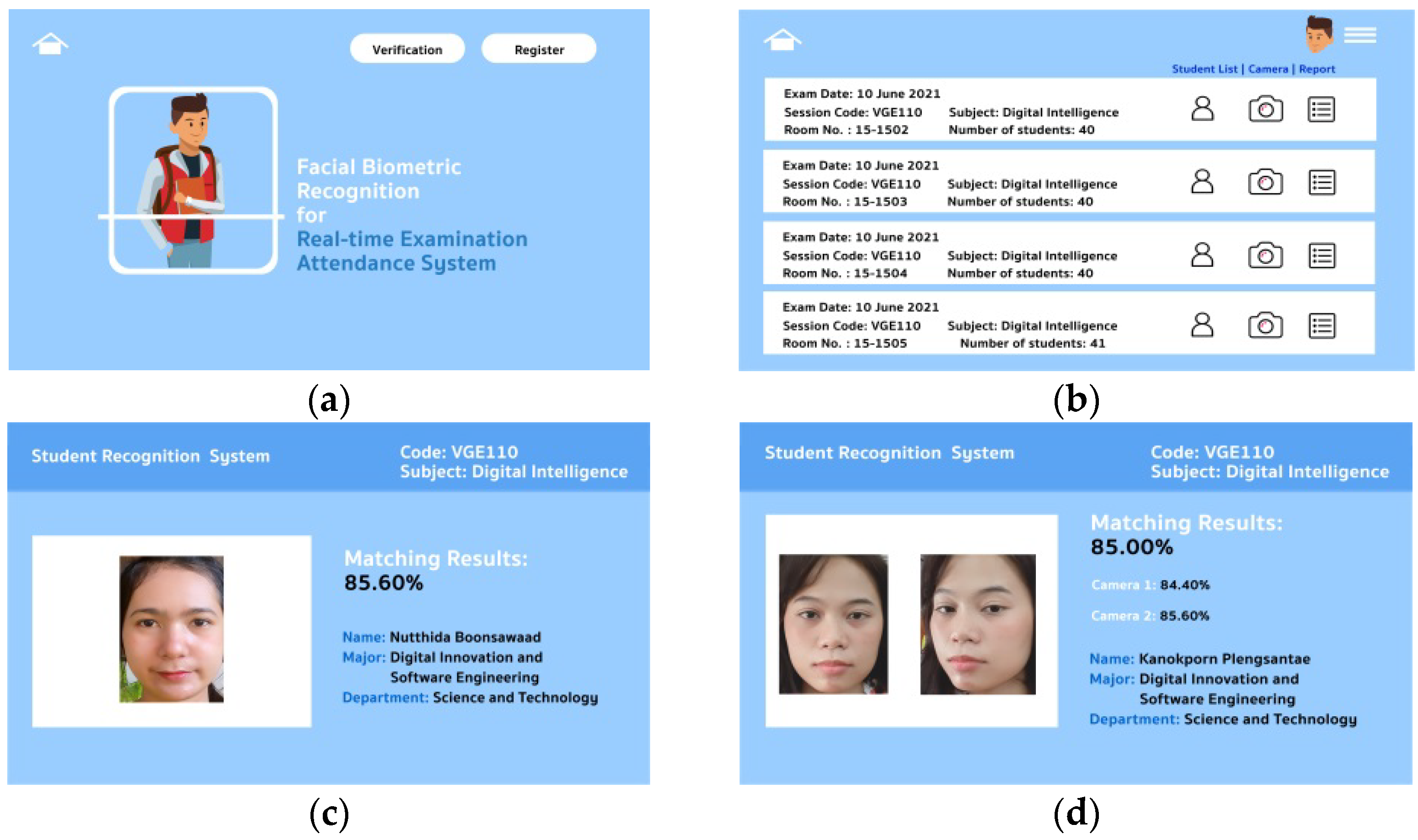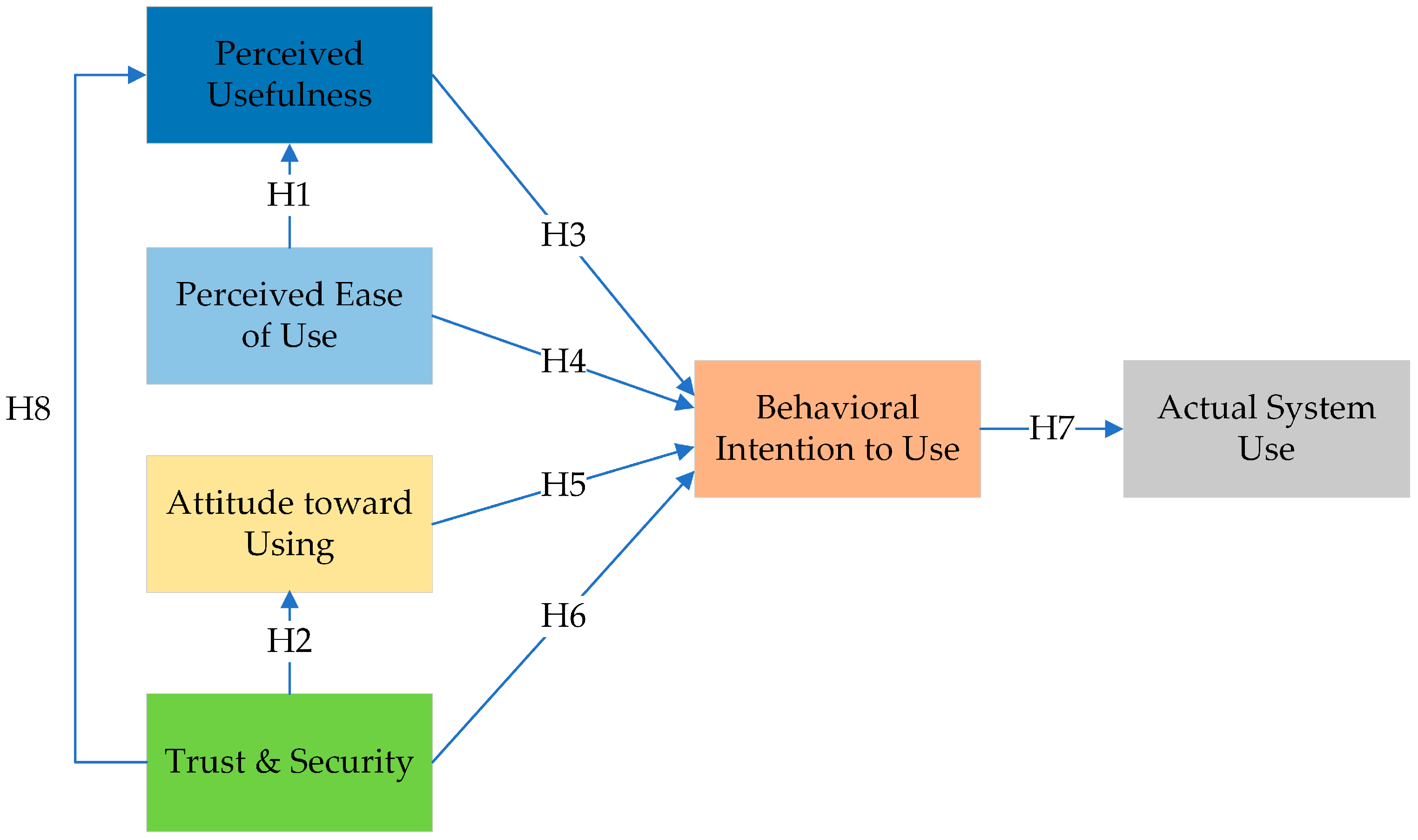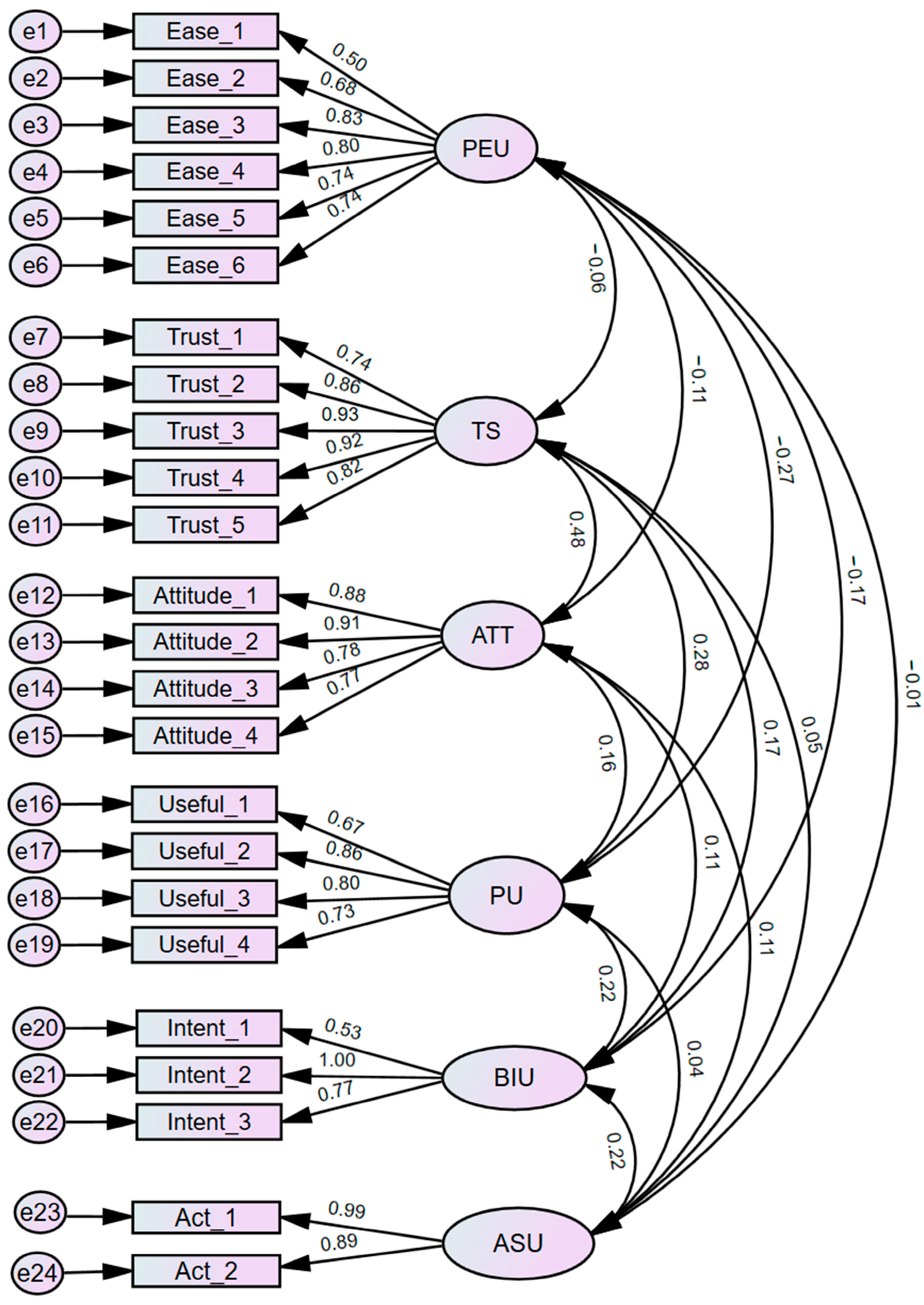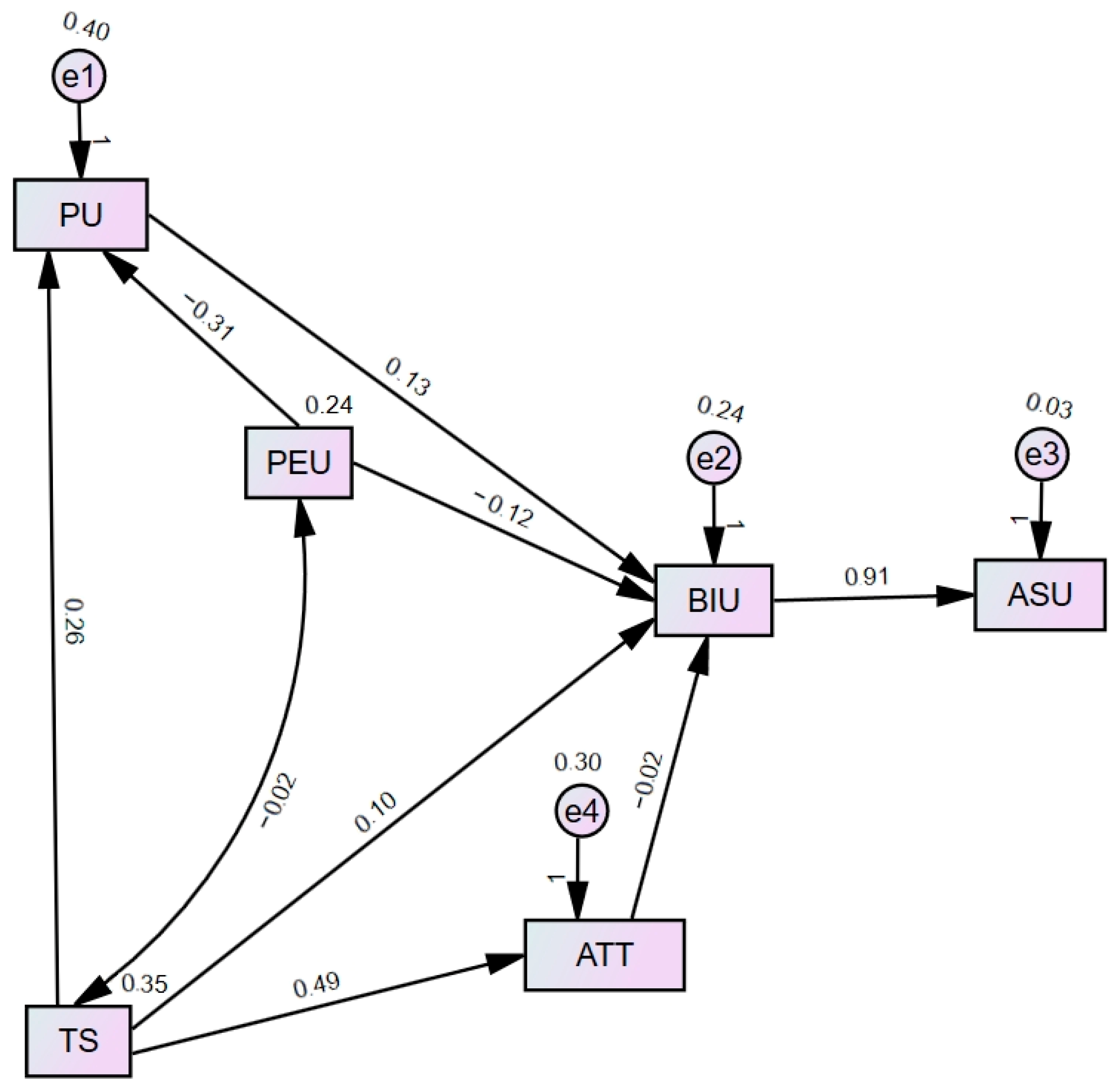User Acceptance Factors Related to Biometric Recognition Technologies of Examination Attendance in Higher Education: TAM Model
Abstract
:1. Introduction
2. Literature Review
2.1. Biometric Technology
2.2. Related Face Recognition
2.3. User Perception Model
3. Materials and Methods
3.1. Proposed Face Recognition Framework
3.2. Instrument
3.3. Instrument Validation and Analysis
3.4. Hypotheses
3.5. Evaluation Design and Data Collection
3.6. Biometric Data Management
4. Result and Discussion
4.1. Desctiptive Statistic
4.2. Reliability Test
4.3. Measurement Model Testing
4.4. Structural Model Estimation
4.5. Hypoteses Test Results
4.6. Discussion
5. Conclusions
5.1. Theoretical Contributions
- The framework for biometric examination attendance recognition was proposed and a prototype application was developed. The study demonstrates the educational biometric recognition framework’s practical outcomes, emphasizing unimodal and multimodal face recognition for first-year undergraduate students. Additionally, the proposed architecture and system provide real-time face recognition of students for examination attendance, information, and accuracy rates of face recognition.
- To investigate students’ actual system use, this research adopted a Model of Technology Acceptance (TAM) and a Theory of Reasoned Action (TRA). The educational biometric recognition factors considered student perceptions of ease of use, usefulness, attitude, trust, and security.
- Trust and security are significantly related to IoT-based face recognition for class attendance because they are essential to protect individuals’ rights and privacy, ensure compliance with laws and regulations, maintain the integrity and security of the system, and build trust with individuals.
- In comparison to traditional and biometric recognition for examination attendance, multimodal face recognition is significantly more useful than unimodal face recognition.
5.2. Practical Implications
5.3. Limitations and Future Work
Author Contributions
Funding
Institutional Review Board Statement
Informed Consent Statement
Data Availability Statement
Conflicts of Interest
References
- Constantinou, C.; Wijnen-Meijer, M. Student evaluations of teaching and the development of a comprehensive measure of teaching effectiveness for medical schools. BMC Med. Educ. 2022, 22, 113. [Google Scholar] [CrossRef] [PubMed]
- Banwarith, R.; Basuhail, A.; Fattouh, A.; Gamalel-Din, S. E-exam cheating detection system. Int. J. Adv. Comput. Sci. Appl. 2017, 8, 176–181. [Google Scholar]
- Vučković, D.; Peković, S.; Blečić, M.; Đoković, R. Attitudes towards cheating behavior during assessing students’ performance: Student and teacher perspectives. Int. J. Educ. Integr. 2020, 16, 13. [Google Scholar] [CrossRef]
- Roshan, A.S.; Gurbaz, M.Q.; Rahmani, S. The effects of large classes on English language teaching. Integr. J. Res. Arts Humanit. 2022, 2, 38–41. [Google Scholar] [CrossRef]
- Lee, J.W. Impact of proctoring environments on student performance: Online vs offline proctored exams. J. Asian Financ. Econ. Bus. 2020, 7, 653–660. [Google Scholar] [CrossRef]
- Anu, V.; Walia, G.; Bradshaw, G. Incorporating human error education into software engineering courses via error-based inspections. In Proceedings of the 2017 ACM SIGCSE Technical Symposium on Computer Science Education, Seattle, WA, USA, 8–11 March 2017; pp. 39–44. [Google Scholar] [CrossRef]
- Abass, O.A.; Olajide, S.A.; Samuel, B.O. Development of web-based examination system using open-source programming model. Turk. Online J. Distance Educ. 2017, 18, 30–42. [Google Scholar] [CrossRef]
- Hameed, M.R.; Abdullatif, F.A. Online examination system. Int. Adv. Res. J. Sci. Eng. Technol. 2017, 4, 106–110. [Google Scholar] [CrossRef]
- Hamid, R.A.; Mokhtar, U.A.; Yusof, M.; Warland, A. Electronic records management in schools: The case study of school examination analysis system. J. Pengur. 2020, 57, 1–13. [Google Scholar] [CrossRef]
- Rukhiran, M.; Napasorn, P.; Netinant, P. Adoption of environmental information chatbot services based on the internet of educational things in smart schools: Structural equation modeling approach. Sustainability 2022, 14, 15621. [Google Scholar] [CrossRef]
- Divya, H.; Nandhini, S.; Shobana, S.; Sujithra, M. Examination management system. Int. J. Adv. Res. Publ. 2021, 9, 920–923. [Google Scholar] [CrossRef]
- Rukhiran, M.; Pukdesree, S.; Netinant, P. Biometric cloud services for web-based examinations: An empirical approach. Int. J. Inf. Technol. 2022, 17, 22. [Google Scholar] [CrossRef]
- Shamsi, S.V.; Andrews, J.V. A survey paper on fingerprint recognition and cross matching. Int. J. Res. Appl. Sci. Eng. Technol. 2019, 7, 573–575. [Google Scholar] [CrossRef]
- Kortli, Y.; Jridi, M.; Falou, A.A.; Atri, M. Face recognition systems: A survey. Sensors 2020, 20, 342. [Google Scholar] [CrossRef]
- Raju, A.S.; Udayashankara, V. A survey on unimodal, multimodal biometrics and its fusion techniques. Int. J. Eng. Technol. 2018, 7, 689–695. [Google Scholar] [CrossRef]
- Rukhiran, M.; Netinant, P. A practical model from multidimensional layering: Personal finance information framework using mobile software interface operations. J. Inf. Commun. Technol. 2020, 19, 321–349. [Google Scholar] [CrossRef]
- Poria, S.; Cambria, E.; Bajpai, R.; Hussain, A. A review of affective computing: From unimodal analysis to multimodal fusion. Inf. Fusion 2017, 37, 98–125. [Google Scholar] [CrossRef]
- Singh, M.; Singh, R.; Ross, A. A comprehensive overview of biometric fusion. Inf. Fusion 2019, 52, 187–205. [Google Scholar] [CrossRef]
- Zainal, I.; Sidek, K.A.; Gunawan, T.S.; Mansor, H.; Kartiwi, M. Design and development of portable classroom attendance system based on Arduino and fingerprint Biometric. In Proceedings of the 5th International Conference on Information and Communication Technology for The Muslim World, Sarawak, Malaysia, 17–19 November 2014. [Google Scholar] [CrossRef]
- Zainal, N.I.; Sidek, K.A.; Gunawan, T.S. Portable anti forgery recognition for attendance system using fingerprint based biometric. ARPN J. Eng. Appl. Sci. 2016, 11, 396–403. [Google Scholar]
- Fenu, G.; Marras, M.; Boratto, L. A multi-biometric system for continuous student authentication in e-learning platforms. Pattern Recognit. Lett. 2018, 113, 83–92. [Google Scholar] [CrossRef]
- Mehta, P.; Tomar, P. An efficient attendance management system based on face recognition using Matlab and Raspberry Pi 2. Int. J. Eng. Res. Technol. 2016, 3, 71–78. [Google Scholar]
- Sayeed, S.; Hossen, J.; Kalaiarasi, S.; Vaithiyashankar, J.; Yusof, I.; Samraj, A. Real-time face recognition for attendance monitoring system. J. Theor. Appl. Inf. Technol. 2017, 95, 24–30. [Google Scholar]
- Traore, I.; Nakkabi, Y.; Saad, S.; Sayed, B.; Ardigo, J.D.; Quinan, P.M. Ensuring Online Exam Integrity through Continuous Biometric Authentication; Springer: New York, NY, USA, 2017; pp. 73–81. [Google Scholar] [CrossRef]
- Ye, M.; Shen, J.; Lin, G.; Xiang, T.; Shao, L.; Hoi, S.C. Deep learning for person re-identification: A survey and outlook. IEEE Trans. Pattern Anal. Mach. Intell. 2022, 44, 2872–2893. [Google Scholar] [CrossRef] [PubMed]
- Yusof, Y.M.; Nasir, M.M.; Othman, K.A.; Suliman, S.I.; Shahbudin, S.; Mohamad, R. Real-time internet-based attendance using face recognition system. Int. J. Eng. Technol. 2018, 7, 174–178. [Google Scholar] [CrossRef]
- Khan, R.U.; Wee, V.C.; Lui, V.W.; UlHaq, M.I.; Khan, Y.; Barawi, M.H. Mobile barcode based examination attendance system. Int. J. Eng. Technol. 2018, 7, 49–54. [Google Scholar] [CrossRef]
- Rahni, A.A.; Zainal, N.; Adna, M.Z.; Othman, N.E.; Bukhori, M.F. Development of the online student attendance monitoring system (SAMS™) based on QR-codes and mobile devices. J. Eng. Sci. Technol. 2015, 10, 28–40. [Google Scholar]
- Mohandes, M.A. Class attendance management system using NFC mobile devices. Intell. Autom. Soft Comput. 2016, 23, 251–259. [Google Scholar] [CrossRef]
- Bhalla, V.; Singla, T.; Gahlot, A.; Gupta, V. Bluetooth based attendance management system. Int. J. Innov. Eng. Technol. 2013, 3, 227–233. [Google Scholar]
- Rjeib, H.D.; Ali, N.S.; Farawn, A.A.; Al-Sadawi, B.; Alsharqi, H. Attendance and information system using RFID and web-based application for academic sector. Int. J. Adv. Comput. Sci. Appl. 2018, 9, 266–274. [Google Scholar] [CrossRef]
- Taileb, M. Design and implementation of RFID and fingerprint-based student verification system design and implementation of RFID and fingerprint-based student verification system. Int. J. Recent. Technol. Eng. 2020, 8, 2084–2092. [Google Scholar] [CrossRef]
- Ahmed, I.B.; Mohamed, M.A.; Noma, A.M. A framework for secure online exam using biometric fingerprint and steganography techniques. Int. J. Eng. Technol. 2018, 7, 32–35. [Google Scholar] [CrossRef]
- Emmanuel, E.; Okonkwo, T. A biometric authentication approach to examination conduct in Nigerian universities. Int. J. Innov. Res. Technol. Sci. Eng. 2019, 8, 2176–2182. [Google Scholar] [CrossRef]
- Mir, G.M.; Balkhi, A.; Lala, N.A.; Sofi, N.A.; Kirmani, M.; Mir, I.A.; Hamid, H.A. The benefits of implementation of biometric attendance system. Oriental J. Comput. Sci. Technol. 2018, 11, 50–54. [Google Scholar] [CrossRef]
- Awojide, S.; Awe, O.S.; Babatope, T.S. Biometric fingerprint system using an online based pattern recognition for candidate’s authentication in Nigeria institution examinations. The Design Perspective. Int. J. Sci. Eng. 2018, 9, 1680–1694. [Google Scholar] [CrossRef]
- Jain, T.; Tomar, U.; Arora, U.; Jain, S. IoT based biometric attendance system. J. Electr. Eng. Technol. 2020, 11, 156–161. [Google Scholar]
- Sunaryono, D.; Siswantoro, J.; Anggoro, R. An android-based course attendance system using face recognition. J. King Saud Univ.—Comput. Inf. Sci. 2021, 33, 304–312. [Google Scholar] [CrossRef]
- Wong-In, S.; Netinant, P. Designing an examinee personal verification system using biometric technology. J. Curr. Sci. Tecnnol. 2018, 8, 75–86. [Google Scholar] [CrossRef]
- Ahmed, A.A. Future effects and impacts of biometrics integrations on everyday living. Al-Mustansiriyah J. Sci. 2019, 29, 139–144. [Google Scholar] [CrossRef]
- Mahfouz, A.; Mahmoud, T.M.; Eldin, S.A. A survey on behavioral biometric authentication on smartphones. J. Inf. Secur. Appl. 2017, 37, 28–37. [Google Scholar] [CrossRef]
- Gawande, U.; Golhar, Y. Biometric security system: A rigorous review of unimodal and multimodal biometrics techniques. Int. J. Biom. 2018, 10, 142–175. [Google Scholar] [CrossRef]
- Walia, G.S.; Singh, T.; Singh, K.; Verma, N. Robust multimodal biometric system based on optimal score level fusion model. Expert Syst. Appl. 2019, 116, 364–376. [Google Scholar] [CrossRef]
- Yang, W.; Wang, S.; Hu, J.; Guanglou, Z.; Valli, C. A fingerprint and finger-vein based cancelable multi-biometric system. Pattern Recognit. 2018, 78, 242–251. [Google Scholar] [CrossRef]
- Ammour, B.; Boubchir, L.; Bouden, T.; Ramdani, M. Face–Iris multimodal biometric identification system. Electronics 2020, 9, 85. [Google Scholar] [CrossRef]
- Gunasekaran, K.; Jayamani, R.; Ramasamy, P. Deep multimodal biometric recognition using contourlet derivative weighted rank fusion with human face, fingerprint and iris images. Automatika 2019, 60, 253–265. [Google Scholar] [CrossRef]
- Zhao, Y.; Xu, J.; Wu, J.; Hao, J.; Qian, H. Enhancing camera-based multimodal indoor localization with device-free movement measurement using WiFi. IEEE Internet Things J. 2020, 7, 1024–1038. [Google Scholar] [CrossRef]
- Chen, Y.; Yang, J.; Wang, C.; Park, D. Variational Bayesian extreme learning machine. Neural Comput. Appl. 2014, 27, 185–196. [Google Scholar] [CrossRef]
- Gomez-Barrero, M.; Maiorana, E.; Galbally, J.; Campisi, P.; Fierrez, J. Multi-biometric template protection based on homomorphic encryption. Pattern Recognit. 2017, 67, 149–163. [Google Scholar] [CrossRef]
- Dass, S.; Sadrulhuda, M.Q.; Pasha, N.N.; Nayan, N.; Nayak, J.S. Real time face recognition using Raspberry Pi. Int. J. Comput. Appl. 2020, 176, 1–4. [Google Scholar] [CrossRef]
- Yadav, S.; Vishwakarma, V.P. Extended interval type-II and kernel based sparse representation method for face recognition. Expert Syst. Appl. 2019, 116, 265–274. [Google Scholar] [CrossRef]
- Nguyen, K.; Fookes, C.; Sridharan, S.; Tistarelli, M.; Nixon, M. Super-resolution for biometrics: A comprehensive survey. Pattern Recogniti. 2018, 78, 23–42. [Google Scholar] [CrossRef]
- Yaddaden, Y.; Adda, M.; Bouzouane, A.; Gaboury, S.; Bouchard, B. User action and facial expression recognition for error detection system in an ambient assisted environment. Expert Syst. Appl. 2018, 112, 173–189. [Google Scholar] [CrossRef]
- Davis, F.D. Perceived usefulness, perceived ease of use, and user acceptance of information technology. MIS Q. 1989, 13, 319–339. [Google Scholar] [CrossRef]
- Kanak, A.; Sogukpinar, I. BioTAM: A technology acceptance model for biometric authentication systems. IET Biom. 2017, 6, 457–467. [Google Scholar] [CrossRef]
- Wang, J.S. Exploring biometric identification in FinTech applications based on the modified TAM. Financ. Innov. 2021, 7, 42. [Google Scholar] [CrossRef]
- Ajzen, I.; Fishbein, M. Understanding Attitudes and Predicting Social Behavior; Prentice–Hall: Hoboken, NJ, USA, 1980. [Google Scholar]
- Sheppard, B.H.; Hartwick, J.; Warshaw, P.R. The theory of reasoned action: A meta-analysis of past research with recommendations for modifications and future research. J. Consum. Res. 1988, 15, 325–343. [Google Scholar] [CrossRef]
- Buabeng-Andoh, C. Predicting students’ intention to adopt mobile learning: A combination of theory of reasoned action and technology acceptance model. J. Res. Innov. Technol. Learn. 2018, 11, 178–191. [Google Scholar] [CrossRef]
- Banga, L.; Pillai, S. Impact of behavioural biometrics on mobile banking system. J. Phys. Conf. Ser. 2021, 1964, 062109. [Google Scholar] [CrossRef]
- DeVellis, R.F.; Thorpe, C.T. Scale Development: Theory and Applications, 5th ed.; Sage Publications: Washington, DC, USA, 2021. [Google Scholar]
- Cronbach, L.J. Coefficient alpha and the internal structure of tests. Psychometrika 1951, 16, 297–334. [Google Scholar] [CrossRef]
- Molnar, G.; Szuts, Z. The role of chatbot in formal education. In Proceedings of the 16th International Symposium on Intelligent Systems and Informatics, Subotica, Serbia, 13–15 September 2018; pp. 197–200. [Google Scholar] [CrossRef]
- Anderson, J.C.; Gerbing, D.W. Structural equation modeling in practice: A review and recommended two-step approach. Psychol. Bull. 1988, 103, 411–423. [Google Scholar] [CrossRef]
- Bentler, P.M.; Chou, C.P. Practical issues in structural modeling. Sociol. Methods Res. 1987, 16, 78–117. [Google Scholar] [CrossRef]
- Huang, Y.C. Integrated concepts of the UTAUT and TPB in virtual reality behavioral intention. J. Retail. Consum. Serv. 2023, 70, 103127. [Google Scholar] [CrossRef]
- Rukhiran, M.; Netinant, P.; Elrad, T. Effecting of environmental conditions to accuracy rates of face recognition based on IoT solution. J. Curr. Sci. Technol. 2020, 10, 21–33. [Google Scholar] [CrossRef]
- Song, B.K. E-portfolio implementation: Examining learners’ perception of usefulness, self-directed learning process and value of learning. Australas. J. Educ. Technol. 2021, 37, 68–81. [Google Scholar] [CrossRef]
- Acosta-Medina, K.K.; Torres-Barreto, M.L.; Cárdenas-Parga, A.F. Students’ preference for the use of gamification in virtual learning environments. Australas. J. Educ. Technol. 2021, 37, 145–148. [Google Scholar] [CrossRef]
- Hassanein, K.; Head, M. Manipulating perceived social presence through the web interface and its impact on attitude towards online shopping. Int. J. Hum. Comput. 2007, 65, 689–708. [Google Scholar] [CrossRef]
- Ngugi, B.; Kamis, A.; Tremaine, M. Intention to use biometric systems. e-Serv. J. 2011, 7, 20–46. [Google Scholar] [CrossRef]
- Norfolk, L.; O’Regan, M. Biometric technologies at music festivals: An extended technology acceptance model. J. Conv. Event Tour. 2021, 22, 36–60. [Google Scholar] [CrossRef]
- Hair, J.F.; Black, W.C.; Babin, B.J.; Anderson, R.E. Multivariate Data Analysis, 7th ed.; Prentice–Hall: Hoboken, NJ, USA, 2010. [Google Scholar]
- Bagozzi, P.R.; Yi, Y. On the evaluation of structural equation models. J. Acad. Mark. Sci. 1964, 16, 74–94. [Google Scholar] [CrossRef]
- Hair, J.F.; Hult, T.G.; Ringle, C.M.; Sarstedt, M. A Primer on Partial Least Squares Structural Equation Modeling (PLS-SEM); Sage Publications: Washington, DC, USA, 2014. [Google Scholar]
- Sidharta, I.; Priadana, S.; Affandi, A. Extending end-user computing satisfaction on academic information systems. Indian J. Sci. Technol. 2016, 9, 1–5. [Google Scholar] [CrossRef]
- Ko, C.H. Exploring employees perceptions of biometric technology adoption in hotels. Biotechnol. Indian J. 2014, 10, 13242–13246. [Google Scholar]
- Morosan, C. Theoretical and empirical considerations of guests’ perceptions of biometric systems in hotels: Extending the technology acceptance model. J. Hosp. Tour. Res. 2012, 36, 52–84. [Google Scholar] [CrossRef]
- Labayen, M.; Vea, R.; Flórez, J.; Aginako, N.; Sierra, B. Online student authentication and proctoring system based on multimodal biometrics technology. IEEE Access 2021, 9, 72398–72411. [Google Scholar] [CrossRef]





| Item | Description | Sample | % |
|---|---|---|---|
| Gender | Male | 92 | 57.10 |
| Female | 69 | 42.90 | |
| Age | 18 | 107 | 66.50 |
| 19 | 54 | 33.50 | |
| Education level | Freshman student | 161 | 100.00 |
| Construct | Description | Mean | SD |
|---|---|---|---|
| Perceived Usefulness (PU) [54,67,68] | PU1: I think face recognition for examination attendance is more useful than the traditional method (student card). | 2.84 | 0.766 |
| PU2: I think multimodal face recognition for examination attendance is more useful than unimodal face recognition. | 3.19 | 0.818 | |
| PU3. The biometric technology is useful for my daily studies. | 2.85 | 0.823 | |
| PU4. The biometric technology helps me increase my productivity during my class. | 2.94 | 0.834 | |
| Perceived Ease of Use (PEU) [54,69] | PEU1: I think face recognition for examination attendance is easier than the traditional method (student card). | 2.85 | 0.654 |
| PEU2: I think multimodal face recognition for examination attendance is easier than the unimodal face recognition. | 3.12 | 0.714 | |
| PEU3: The biometric recognition is easy to use. | 2.80 | 0.614 | |
| PEU4: One of the reasons this system is useful is because of its ease of use. | 2.87 | 0.603 | |
| PEU5: The student recognition is simpler to identify than the traditional method. | 2.92 | 0.642 | |
| PEU6: Biometric recognition does not require much effort to identify myself. | 2.74 | 0.657 | |
| Trust and Security (TS) [56,70] | TS1: The biometric recognition would be physically invasive. | 4.01 | 0.680 |
| TS2: I would trust the face recognition system. | 4.01 | 0.652 | |
| TS3: Student identification using biometric recognition is reliable. | 4.04 | 0.660 | |
| TS4: The system can identify me correctly. | 3.99 | 0.707 | |
| TS5: The system has high recognition accuracy. | 3.96 | 0.660 | |
| Attitude (ATT) [57] | ATT1: I feel that using biometric technology better than I expect. | 3.89 | 0.707 |
| ATT2: Most of my expectations of using face recognition system were confirmed. | 3.89 | 0.689 | |
| ATT3: I feel pretty much use biometric technology in my study. | 3.74 | 0.712 | |
| ATT4: I can trust the biometric recognition system because of high security. | 3.77 | 0.700 | |
| Behavioral Intention to Use (BIU) [57,71] | BIU1: I prefer biometric recognition for examination attendance than the traditional method. | 3.20 | 0.593 |
| BIU2: I will use facial biometric recognition when I have an examination attendance. | 3.59 | 0.586 | |
| BIU3: I hope that biometric technology can be applied in university as soon as possible. | 3.52 | 0.571 | |
| Actual System Use (ASU) [72] | ASU1: I would use a face recognition system for examination attendance. | 3.70 | 0.537 |
| ASU2: I would recommend my university use a face recognition system for student identification in all authentication areas. | 3.78 | 0.559 |
| Construct | Item | Factor Loadings >0.50 | CR >0.70 | AVE >0.50 | Cronbach’s Alpha >0.70 |
|---|---|---|---|---|---|
| Perceived Usefulness (PU) | PU1 PU2 PU3 PU4 | 0.799 0.915 0.818 0.759 | 0.850 | 0.589 | 0.846 |
| Perceived Ease of Use (PEU) | PEU1 PEU2 PEU3 PEU4 PEU5 PEU6 | 0.622 0.750 0.856 0.781 0.800 0.789 | 0.864 | 0.520 | 0.859 |
| Trust and Security (TS) | TS1 TS2 TS3 TS4 TS5 | 0.790 0.869 0.959 0.913 0.861 | 0.932 | 0.735 | 0.932 |
| Attitude (ATT) | ATT1 ATT2 ATT3 ATT4 | 0.853 0.888 0.892 0.828 | 0.902 | 0.699 | 0.903 |
| Behavioral Intention to Use (BIU) | BIU1 BIU2 BIU3 | 0.679 0.900 0.925 | 0.823 | 0.623 | 0.801 |
| Actual System Use (ASU) | ASU1 ASU2 | 0.954 0.946 | 0.937 | 0.881 | 0.934 |
| Construct | PU | PEU | TS | AT | BIU | ASU |
|---|---|---|---|---|---|---|
| PU | 0.767 | |||||
| PEU | −0.269 ** | 0.721 | ||||
| TS | 0.280 ** | −0.059 | 0.858 | |||
| ATT | 0.160 † | −0.108 | 0.480 *** | 0.836 | ||
| BIU | 0.224 * | −0.165 † | 0.175 * | 0.114 | 0.789 | |
| ASU | 0.042 | −0.008 | 0.051 | 0.108 | 0.220 * | 0.939 |
| Model | x2 | df | x2/df | GFI | RMSEA | RMR | NFI | CFI | IFI | TLI |
|---|---|---|---|---|---|---|---|---|---|---|
| Standards | 1 < x2/df < 3 | ≥0.90 | ≤0.08 < 0.1 | ≤0.08 < 0.1 | ≥0.90 | ≥0.90 | ≥0.90 | ≥0.90 | ||
| Acquired | 437.90 | 237 | 1.848 | 0.907 | 0.073 | 0.028 | 0.938 | 0.917 | 0.918 | 0.903 |
| Model | x2 | df | x2/df | GFI | RMSEA | RMR | NFI | CFI | IFI | TLI |
|---|---|---|---|---|---|---|---|---|---|---|
| Criteria | 1 < x2/df < 3 | ≥0.90 | ≤0.08 < 0.1 | ≤0.08 < 0.1 | ≥0.90 | ≥0.90 | ≥0.90 | ≥0.90 | ||
| Obtained | 7.776 | 6 | 1.296 | 0.984 | 0.043 | 0.008 | 0.940 | 0.996 | 0.996 | 0.996 |
| Hypotheses | Relationship (Positive) | Value | p-Value | Results |
|---|---|---|---|---|
| H1 | PEU → PU | −0.228 | 0.002 ** | Accepted |
| H2 | TS → ATT | 0.469 | 0.000 *** | Accepted |
| H3 | PU → BIU | 0.169 | 0.036 ** | Accepted |
| H4 | PEU → BIU | −0.117 | 0.137 | Rejected |
| H5 | ATT → BIU | −0.024 | 0.780 | Rejected |
| H6 | TS → BIU | 0.115 | 0.194 | Rejected |
| H7 | BIU → ASU | 0.938 | 0.000 *** | Accepted |
| H8 | TS → PU | 0.230 | 0.002 ** | Accepted |
Disclaimer/Publisher’s Note: The statements, opinions and data contained in all publications are solely those of the individual author(s) and contributor(s) and not of MDPI and/or the editor(s). MDPI and/or the editor(s) disclaim responsibility for any injury to people or property resulting from any ideas, methods, instructions or products referred to in the content. |
© 2023 by the authors. Licensee MDPI, Basel, Switzerland. This article is an open access article distributed under the terms and conditions of the Creative Commons Attribution (CC BY) license (https://creativecommons.org/licenses/by/4.0/).
Share and Cite
Rukhiran, M.; Wong-In, S.; Netinant, P. User Acceptance Factors Related to Biometric Recognition Technologies of Examination Attendance in Higher Education: TAM Model. Sustainability 2023, 15, 3092. https://doi.org/10.3390/su15043092
Rukhiran M, Wong-In S, Netinant P. User Acceptance Factors Related to Biometric Recognition Technologies of Examination Attendance in Higher Education: TAM Model. Sustainability. 2023; 15(4):3092. https://doi.org/10.3390/su15043092
Chicago/Turabian StyleRukhiran, Meennapa, Sethapong Wong-In, and Paniti Netinant. 2023. "User Acceptance Factors Related to Biometric Recognition Technologies of Examination Attendance in Higher Education: TAM Model" Sustainability 15, no. 4: 3092. https://doi.org/10.3390/su15043092






